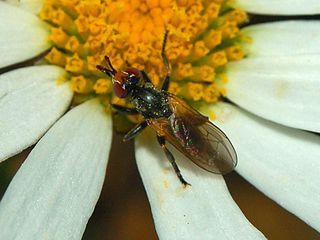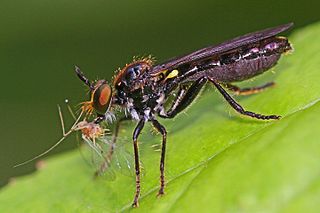
Phyllostachys is a genus of Asian bamboo in the grass family. Many of the species are found in central and southern China, with a few species in northern Indochina and in the Himalayas. Some of the species have become naturalized in parts of Asia, South America, Australia, and southern Europe.

Coprosma is a genus of flowering plants in the family Rubiaceae. It is found in New Zealand, Hawaiian Islands, Borneo, Java, New Guinea, islands of the Pacific Ocean to Australia and the Juan Fernández Islands.

Ulmus davidiana var. japonica, the Japanese elm, is one of the larger and more graceful Asiatic elms, endemic to much of continental northeast Asia and Japan, where it grows in swamp forest on young alluvial soils, although much of this habitat has now been lost to intensive rice cultivation.

Coneweb spiders (Diguetidae) are six-eyed haplogyne spiders that live in tangled space webs, fashioning a cone-like central retreat where they hide and lay eggs. It is a small family, containing only two genera split between a range in the Southwestern United States and Mexico and a range in South America. Members of the genus Diguetia usually build their webs in shrubs or between cactus pads. They have the same eye arrangement as the venomous recluse spiders.

Campiglossa is a genus of fruit flies in the family Tephritidae. There are at least 190 described species in Campiglossa.

Thecophora is a genus of thick-headed fly from the family Conopidae.

Thecophora atra is a species of small fly in the family Conopidae subfamily Myopinae.

Tramea transmarina, known as the red glider or northern glider, is a species of dragonfly in the Libellulidae family. The type locality for Tramea transmarina is Fiji, but subspecies are found in the islands of the Pacific, north-eastern Australia and Southeast Asia.

Spatalla is a genus containing 20 species of flowering plants, commonly known as "spoons", in the family Proteaceae. The genus is endemic to the Cape Floristic Region of South Africa where it is associated with fynbos habitats. The species are all small shrubs. The name is derived from the Greek, meaning “wantonness”, alluding to the plants’ unusually large pollen-presenters. Most species are threatened.

iNaturalist is an American 501(c)(3) nonprofit social network of naturalists, citizen scientists, and biologists built on the concept of mapping and sharing observations of biodiversity across the globe. iNaturalist may be accessed via its website or from its mobile applications. iNaturalist includes an automated species identification tool, and users further assist each other in identifying organisms from photographs and even sound recordings. As of 9 July 2024, iNaturalist users had contributed approximately 197,660,888 observations of plants, animals, fungi, and other organisms worldwide, and 290,007 users were active in the previous 30 days.
Acleris ulmicola is a species of moth of the family Tortricidae. It is found in South Korea, China, Japan, Taiwan and Russia.
Gunniopsis propinqua is a succulent plant in the iceplant family, Aizoaceae. It is endemic to Western Australia.
Glaenocorisa propinqua is a species in the family Corixidae, in the order Hemiptera . The distribution range of Glaenocorisa propinqua includes Europe, Northern Asia, and North America. It can be found in lakes, and its distribution is influenced by the presence of fish, which prey upon the larvae.

Metadelphax propinqua is a species of delphacid planthoppers in the family Delphacidae. It is found in Africa, Australia, the Caribbean, Europe, Northern Asia, Central America, North America, Oceania, South America, and Southern Asia. It is an introduced species in the Nearctic and Neotropic.

Eudioctria is a genus of robber flies in the family Asilidae. There are about 14 described species in Eudioctria.
Tumidagena is a genus of delphacid planthoppers in the family Delphacidae. There are at least three described species in Tumidagena.
Eudioctria propinqua is a species of robber flies in the family Asilidae.

Formica propinqua is a species of ant in the family Formicidae.

Cerotainia is a genus of robber flies in the family Asilidae. There are at least 30 described species in Cerotainia.
Tumidagena propinqua is a species of delphacid planthopper in the family Delphacidae. It is found in North America.














